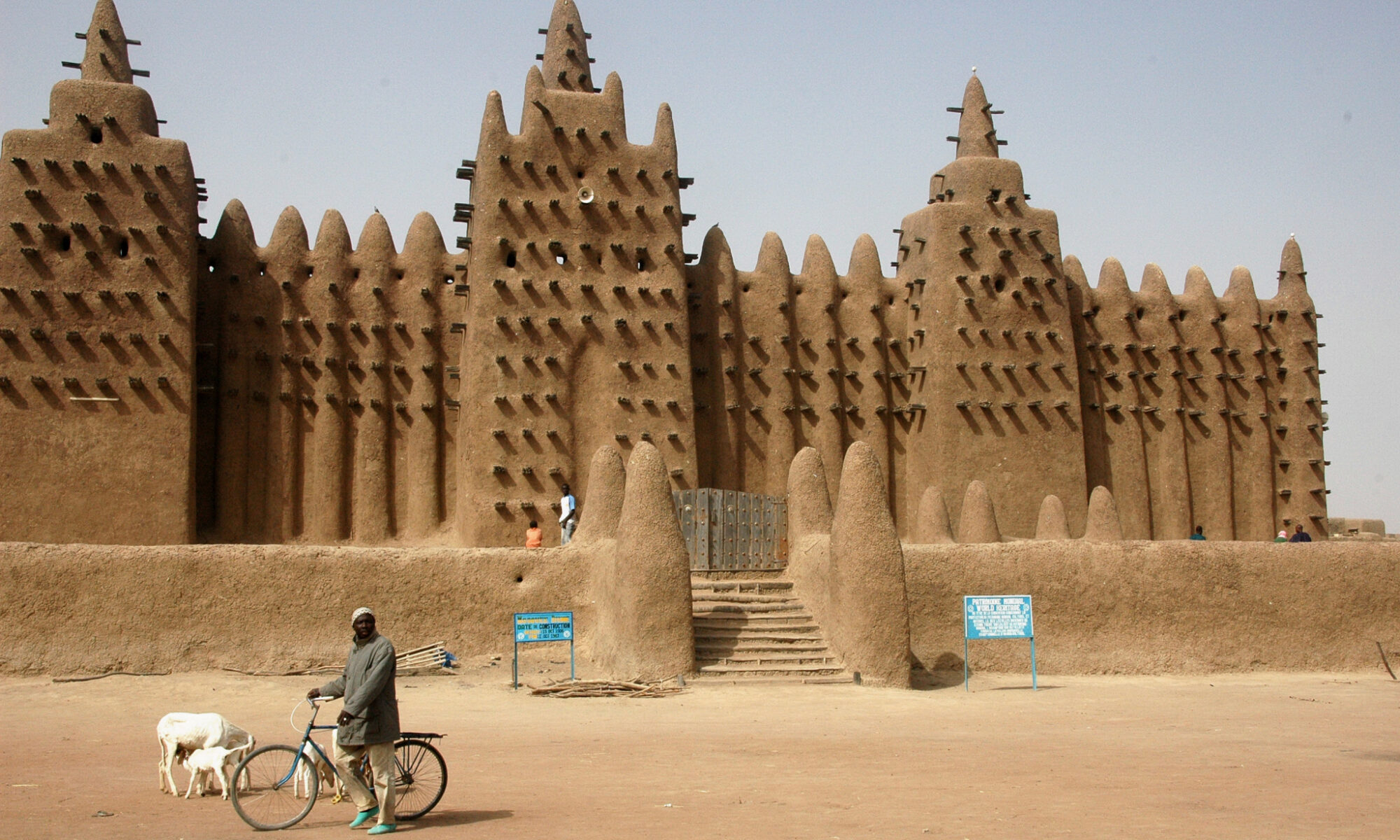The ceremonial enclosure of Khasekhemwy–Hierakonpolis’ only standing monument is built entirely of sun-dried mud brick, with walls 5 meters (16.4 feet) thick and still preserved in places to its original imposing height of 9 meters (29.5 feet). It is the oldest freestanding mud-brick structure in the world. For the third time, it has been listed with the World Monument Fund as one of the world’s 100 most endangered monuments. Decorated on its exterior with a pattern of recessed paneling or niches and originally plastered white, it must have been a striking sight in its time. Almost 5,000 years later, it stands as a testament to the abilities of its builder, King Khasekhemwy, the last ruler of the Second Dynasty (ca. 2686 B.C.), but the reasons for which it was built remain a mystery.
Adobe International Research Institute
The Historical airport of Maybod in Yazd Province has been suggested by the Maybod Research Center as the center for the Adobe International Research Institute. Considering that Iran is an earthquake-prone country, establishing an international research institute for studying earthen structures would provide a proper basis for reengineering and strengthening of these structures. “Taking into account that Iran has the highest number of earthen constructions in the world, this decision would provide international facilities for preserving these monuments. Earthen constructions are parts of Iranian traditional architectural style which has a history of over 8000 years. Establishing an international center in Iran would promote Iran’s technical abilities in regards to earthen structures. Keeping in mind that Iran is an earthquake-prone country, the establishment of this center would also provide an opportunity to reengineer and strengthen our clay structures according to the international standards,” said Mohammad Hassan Khademzadeh, head of Mega Projects.
Earth Ammunition
In the ruins of an ancient mud-brick city in northeastern Syria, archaeologists have uncovered what they say is substantial evidence of a fierce battle fought there in about 3500 B.C., which includes the discovery of 120 clay balls that were meant to be fired from slings, as well as 1,200 smaller “bullets.”
The Complete Works of Hassan Fathy
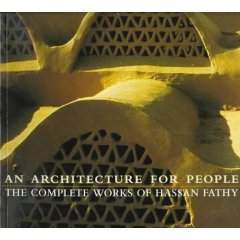
An Architecture for People: The Complete Works of Hassan Fathy reviews the ideas and designs of Egyptian architect Hassan Fathy (1900-1989), best known for his striking Architecture for the Poor (University of Chicago, 1973), which described his efforts to create the village of New Gourna for 7,000 displaced Egyptian peasants known as the Gourni. Fathy sought to empathize with their lifeworld and to find architectural means whereby the new village would sustain their traditional way of life yet at the same time make life better by drawing on sustainable technology.
Steele, an architect himself, presents Fathy’s built projects and discusses the design philosophy underlying his work. Steele’s book is a tribute to Fathy as a compassionate designer and as a master craftsman who held strongly to traditional values and beliefs at a time when the historical amnesia and standardization of Modernist architecture dominated.
Earthen architecture in Iran and Central Asia Conference
Earthen architecture in Iran and Central Asia: its conservation, management, and relevance to contemporary society, a celebration of the life and work of Robert Byron, will be held at the Institute of Archaeology, University College London, 12-13th November 2005. The aim of the conference is to bring together individuals involved in the conservation and management of the archaeological and architectural legacy of earthen architecture in Iran and Central Asia, to discuss current approaches, practical applications, new projects and the impact of work on local communities and contemporary society.
Hassan Fathy
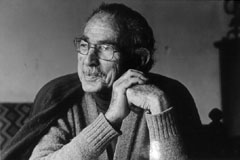
The Hassan Fathy web site is the first, and perhaps the most comprehensive, website on the great Egyptian architect. The site documents 105 projects with photos, essays and drawings and is available in English, French and Arabic.
The Tarim Conservation Project
The Tarim Conservation Project website documents the preservation of historic palaces of the Hadhramaut Valley in Tarim, Yemen. The principal investigators are art historian/archaeologist Dr. Selma Al-Radi, co-director of the ‘Amiriya Restoration Project in Rada’, Yemen, and architect/architectural conserator Pamela Jerome, an adjunct associate professor at Columbia University’s Graduate School of Architecture, Planning and Preservation (GSAPP) and a senior associate with Wank Adams Slavin Associates, a New York architecture and engineering firm. The trainees will be students from the historic preservation program of the GSAPP, along with Museum of the Hadhramaut personnel, and architecture students from the University of Mukallah. The significance of the Tarimi palaces and the fact that most of them are undocumented led us to propose their listing on the World Monuments Fund 100 Most Endangered Sites list for 2000-01. We have just received word that the site has been selected for re-listing on the 100 Most Endangered Sites list for 2002-03. Be sure to check out the visual resources page.
Bam: One Year Later
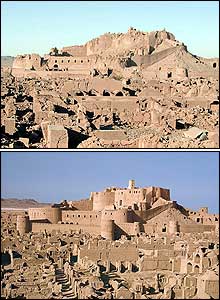
Some 26,000 lives were lost in the earthquake of 26 December last year, which levelled most recent housing, leaving about 80,000 people homeless, and damaged the ancient Bam Citadel. More:
UN, Iran mark first anniversary of earthquake that devastated Bam cultural area
Bam Before and After from Columbia University [username: ahar and password: 826sch to access site]
Al-Abbas Mosque
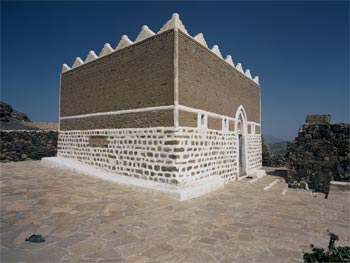
Al-Abbas Mosque is a testimony to the living traditions and architectural achievements of one of the world’s earliest civilizations. Built over 800 years ago, the mosque is situated on the remains of a pre-Islamic shrine or temple on a site considered sacred since ancient times. Its cubic form also has ancient precedents, including the Kaaba in Mecca. The local population continues to revere the mosque and the site today still holds special significance for them. The Al-Abbas Mosque restoration project is a recipient of the Aga Khan Award for Architecture, Ninth Award Cycle, 2002 – 2004.
The Valley of Mud-Brick Architecture
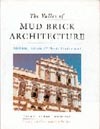
The Valley of Mud-Brick Architecture by Salma Samar Damluji is a scholarly book concentrating on the architecture and town planning of two towns in the Hadhramawt, Shibam and Tarim, Yemen. It looks at the very ancient origins of the south Arabian mud built architecture, its suitability for the climate, its adaptability, and its relative virtues compared with imported Western practices and how it can continue to develop as an indigenous Arabian art or science. It is clearly an exciting study to any such as Dr. Damluji, who had worked with and is clearly an admirer of Hassan Fathy, the great exponent of traditional mud brick architecture in Cairo. Read a review.
